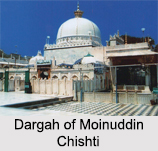 Tourism in Ajmer attracts a number of visitors for the famous "dargah" or mausoleum of Sufi saint Khwaja Moin-ud-Din Chishti. Ajmer is part of the Ajmer district. From times immemorial Ajmer has been an integral part of the history of Rajasthan. The city is nestled amidst the Aravalli ranges. The city is known for its picturesque location. To add to its beauty there is the massive structure of Taragarh Hill and the Ana Sagar, an artificial lake.
Tourism in Ajmer attracts a number of visitors for the famous "dargah" or mausoleum of Sufi saint Khwaja Moin-ud-Din Chishti. Ajmer is part of the Ajmer district. From times immemorial Ajmer has been an integral part of the history of Rajasthan. The city is nestled amidst the Aravalli ranges. The city is known for its picturesque location. To add to its beauty there is the massive structure of Taragarh Hill and the Ana Sagar, an artificial lake.
History of Ajmer
The Rajputs Chauhans established the city. It was Prithviraj Chauhan who is probably responsible for immortalizing Ajmer`s name in the history of Rajasthan. The district of Ajmer evolved around the city much later. Found in the 7th century by the Chauhan dynasty, even today the city remains an important tourist destination in Rajasthan. From the time of its inception the city had witnessed tumultuous times. It was not before the reign of Mughal Emperor Akbar that the city of Ajmer could receive political stability. After Indian independence it was merged with the republic of India.
Popular Places of Ajmer
Ajmer city is well planned with wide streets and impressive buildings. It is the city where a number of places of interest are located. Following are the popular places of Ajmer:
Dargah of Moinuddin Chishti: The Dargah of the Muslim Sufi saint Moinuddin Chishti, the Gharib Nawaz. Besides the dargah there are the ruins of the ancient fort of Taragarh and Adhai-din-ka-Jhonpra.
Adhai Din ka Jhopara: It is a Masjid built by Qutub-ud-Din-Aibak, first Sultan of Delhi in AD 1199. It is a historical object of an old mosque which was constructed with the remains of Hindu and Jain temples.
The Saint`s Tomb: It is at the centre of the courtyard which is enclosed by a silver platform. The tomb attracts thousands of pilgrims during the "Urs-honouring" the death anniversary of the Sufi Saint.
Ajmer Museum: It features a rich storehouse of the Mughal and Rajput body shield and subtle sculptures. The construction is built of red sandstones, which have been positioned in a square pattern giving it a magnificent view.
Taragarh Fort: The fort attracts the visitors to take a bright look at the complete city from here. All the military activities in the Mughal Period used to happen at this place and later on it was utilized by the British as a clinic.
Kishangarh Fort: It is located at a distance of 27 kilometres from Ajmer. This place had one of the best schools for miniature paintings earlier.
Ana Sagar Lake: It is a beautiful lake, situated in the North of Ajmer. The `Baradari`, a sandstone marquee was constructed by Shah Jahan and the Daulat Bagh Gardens were created and preserved by Jahangir.
Foy Sagar Lake: It is another artificial lake, located 5 kilometres from Ajmer, which is worth a visit. It was created in a famine relief programme; the lake was named after the engineer who made the lake possible.
Mayo College: It was one of the India"s most popular public schools. Now it has been converted into a Circuit House. People can also enjoy the great sights of the lake, the cenotaph and the temple of Swami Dayanand Saraswati.
Nasiyan Ji Mandir in Ajmer: It is effortlessly designed with the gold-plated figures of peacocks and elephants from Jain mythology to different continents of the world. Nasiyan Ji Mandir is made of two storeys and is divided into two parts, one of which is a prayer area and the other a museum.
The nearest airport to the city is in Jaipur. From the airport, rented cars and taxis are available to arrive at Ajmer city.



















